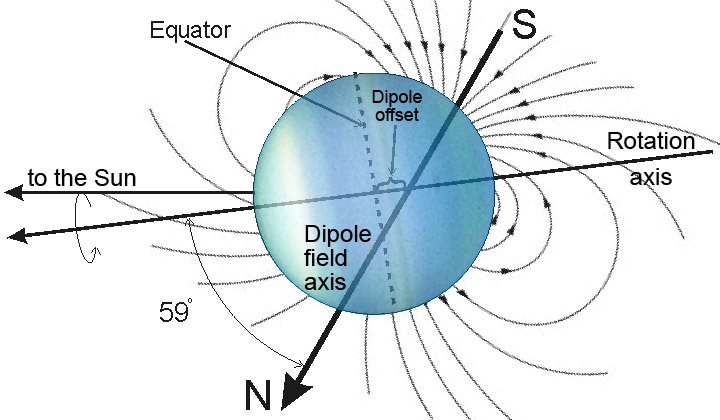MessageToEagle.com – We have previously seen that auroras on alien worlds can be really magnificent and these latest images show the lights also can be very unique.
For the first time, Earth-based telescope have captured images of auroras above the giant ice planet Uranus.
Detected by means of carefully scheduled observations from the Hubble Space Telescope, the newly witnessed Uranian light show consisted of short-lived, faint, glowing dots – a world of difference from the colorful curtains of light that often ring Earth’s poles.
In the new observations, which are the first to glimpse the Uranian aurora with an Earth-based telescope, the researchers detected the luminous spots twice on the dayside of Uranus – the side that’s visible from Hubble.
Previously, the distant aurora had only been measured using instruments on a passing spacecraft.
Unlike auroras on Earth, which can turn the sky greens and purples for hours, the newly detected auroras on Uranus appeared to only last a couple minutes.
In general, auroras are a feature of the magnetosphere, the area surrounding a planet that is controlled by its magnetic field and shaped by the solar wind, a steady flow of charged particles emanating from the sun.
Auroras are produced in the atmosphere as charged solar wind particles accelerate in the magnetosphere and are guided by the magnetic field close to the magnetic poles – that’s why the Earthly auroras are found around high latitudes.
But contrary to the Earth – or even Jupiter and Saturn – “the magnetosphere of Uranus is very poorly known,” said Laurent Lamy, with the Observatoire de Paris in Meudon, France, who led the new research.

Auroras on Uranus are fainter than they are on Earth, and the planet is more than 4 billion kilometers (2.5 billion miles) away. Previous Earth-bound attempts to detect the faint auroras were inconclusive.
Astronomers got their last good look at Uranian auroras 25 years ago when the Voyager 2 spacecraft whizzed past the planet and recorded spectra from of the radiant display.
“This planet was only investigated in detail once, during the Voyager flyby, dating from 1986. Since then, we’ve had no opportunities to get new observations of this very unusual magnetosphere,” Lamy noted.
Planetary scientists know that Uranus is an oddball among the solar system’s planets when it comes to the orientation of its rotation axis. Whereas the other planets resemble spinning tops, circulating around the Sun, Uranus is like a top that was knocked on its side – but still keeps spinning.
The researchers suspect that the unfamiliar appearance of the newly observed auroras is due to Uranus’ rotational weirdness and peculiar traits of its magnetic axis. The magnetic axis is both offset from the center of the planet and lists at an angle of 60 degrees from the rotational axis – an extreme tilt compared to the 11 degree difference on Earth.
Scientists theorize that Uranus’s magnetic field is generated by a salty ocean within the planet, resulting in the off-center magnetic axis.
The 2011 auroras differ not only from Earth’s auroras but also from the Uranian ones previously detected by Voyager 2. When that spacecraft made its flyby decades ago, Uranus was near its solstice – its rotational axis was pointed toward the Sun.
In that configuration, the magnetic axis stayed at a large angle from the solar wind flow, producing a magnetosphere similar to the Earth’s magnetosphere, although more dynamic. Under those 1986 solstice conditions, the auroras lasted longer than the recently witnessed ones and were mainly seen on the nightside of the planet, similar to what’s observed on Earth, Lamy said. Hubble can’t see the far side of the planet, so researchers don’t know what types of auroras, if any, were generated there.
The new set of observations, however, is from when the planet was near equinox, when neither end of the Uranian rotational axis aims at the Sun, and the axis aligns almost perpendicular to the solar wind flow.
Because the planet’s magnetic axis is tilted, the daily rotation of Uranus during the period around the equinox causes each of its magnetic poles to point once a day toward the Sun, likely responsible for a very different type of aurora than the one that was seen at solstice, Lamy explained.
“This configuration is unique in the solar system,” added Lamy, who noted that the two transient, illuminated spots observed in 2011 were close to the latitude of Uranus’s northern magnetic pole.
Capturing the images of Uranus’s auroras resulted from a combination of good luck and careful planning. In 2011, Earth, Jupiter and Uranus were lined up so that the solar wind could flow from the Sun, past Earth and Jupiter, and then toward Uranus.
When the Sun produced several large bursts of charged particles in mid-September 2011, the researchers used Earth-orbiting satellites to monitor the solar wind’s local arrival two to three days later. Two weeks after that, the solar wind sped past Jupiter at 500 kilometers per second (310 miles per second). Calculating that the charged particles would reach Uranus in mid-November, the team scrambled to scheduled time on the Hubble Space Telescope.
Ever since the Voyager 2 flyby demonstrated that Uranus was a “strange beast,” said Fran Bagenal, a planetary scientist with the University of Colorado in Boulder, “we’ve been really keen to get a better view. This was a very clever way of looking at that.”
A better understanding of Uranus’ magnetosphere could help scientists test their theories of how Earth’s magnetosphere functions, she added. “We have ideas of how things work on Earth and places like Jupiter and Saturn, but I don’t believe you really know how things work until you test them on a very different system.”
MessageToEagle.com







